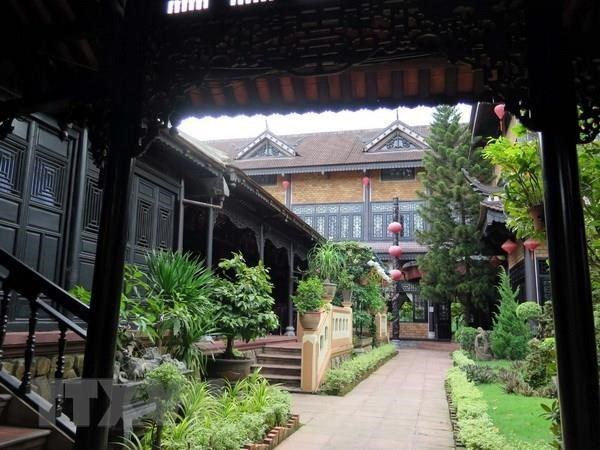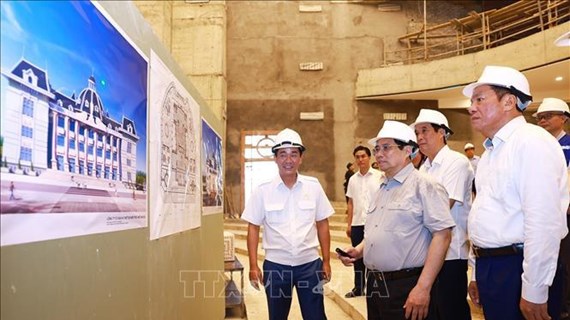Nha vuon - fabulous architecture of Hue
 Nha vuon in Hue maintains all the characteristics of the original garden house (Photo: VietnamPlus)
Nha vuon in Hue maintains all the characteristics of the original garden house (Photo: VietnamPlus)
Hanoi (VNA) – Nha vuon (garden houses), which dots around Hue city in the central province of Thua Thien – Hue, offer visitors a glimpse into a spellbinding ancient architecture.
A typical nha vuon in Hue maintains all the characteristics of the original garden house: a surrounding garden of various plants, trees and bonsai, a water-lily pond, a binh phong (masonry screen) and at the centre of the garden, a nha ruong with 48 columns for the cult of the ancestors and Buddha.
Blossoming under the Nguyen Dynasty, the last royal monarchy (1802 – 1945) in Vietnam’s history, An Hien and other nha vuon like Lac Tinh Vien, Tinh Gia Vien, Ty Ba Trang or Ngoc Son Cong Chua together created a prominent feature of Hue.
The symbiotic relation between gardens and Hue’s people is the glue that keeps these ancient areas intact.
Huu Ngoc, a renowned Vietnamese culture researcher, explains the meaning of the word nha vuon: "This word designates an architectural type, found specially in Hue, with which the home is integrated organically into the garden, the plants and the surrounding landscape to the extent that the ‘whole’ creates a certain spirituality. One can also translate nha vuon as ‘house garden’ because, in many ways, the garden modifies the house itself."
However, if nha vuon means merely a house and a garden, it may be mistaken with ordinary gardens in other parts of the country.
Dao Hung, another culture researcher and also a Hue native, says: "Many people believe that nha vuon is not available in other localities in Vietnam, but it is not true. However, the architecture of nha vuon in Hue is quite different from those in other provinces."
Usually, a typical nha vuon Hue comprises two main parts: nha ruong and the surrounding garden, designed according to geomancy and their owner’s spiritual life and skill. Each nha ruong is built with many beams (ruong) and pillars (cot), and its name derives from this very characteristic. But the most distinctive feature is that all beams and pillars are joined by mortise and tenon, not nails.
Roofed with brick tiles, nha ruong has all beams and pillars made of precious and solid wood, such as lim (iron wood), gu (sindora) or thong xanh (teranthera pine). The whole house stands on big pillars placed on a round or square stone base.
Moreover, different from gardens of the North or South, gardens in Hue serve more decorative, rather than practical desires. While a common garden in the North or the South often specialises in a specific plant, the house-garden in Hue often includes various species of trees, plants and also vegetables.
Tall trees are planted around the first green fence embracing the house-garden. The second fence sits among ornamental plants or fruit trees like the orange or the mangosteen. Along the alley leading from the gate to the house are trellises of flowers, providing a cool and decorative "roof" to the garden.
Hue makes efforts to preserve the old structures
Hue city is currently housing over 1,000 nha vuon, mostly in Gia Hoi, Vi Da and Kim Long wards. The old structure is now at risk of become deteriorated due to ravages of time, as well as rapid pace of urban development.
 Fabulous nha vuon like An Hien, Lac Tinh Vien, Tinh Gia Vien, Ty Ba Trang or Ngoc Son Cong Chua together created a prominent feature of Hue. (Photo: VietnamPlus)
Fabulous nha vuon like An Hien, Lac Tinh Vien, Tinh Gia Vien, Ty Ba Trang or Ngoc Son Cong Chua together created a prominent feature of Hue. (Photo: VietnamPlus)
Tradition says that nha vuon cannot be sold out of the family in order to keep ancestral links firm. However, rocketing land values have urged some people to sell their land or dissemble the nha ruong.
Some homeowners cannot afford to restore their nha ruong, so they dissemble them to sell to people from other localities. If this trend continues, all the valuable knowledge stored in those nha ruong will disappear into history and culture books.
To deal with the situation, the provincial People’s Committee outlined and issued policies to support preservation and value promotion of typical nha vuon Hue.
Accordingly, during 2015-2020, the province splashed out 5-8 billion VND (216,000 – 345,800 USD) to restore 3-5 nha vuon each year.
The preserved houses must cover an area of at least 600 square metres, and have special feature of nha vuon in Hue./.













